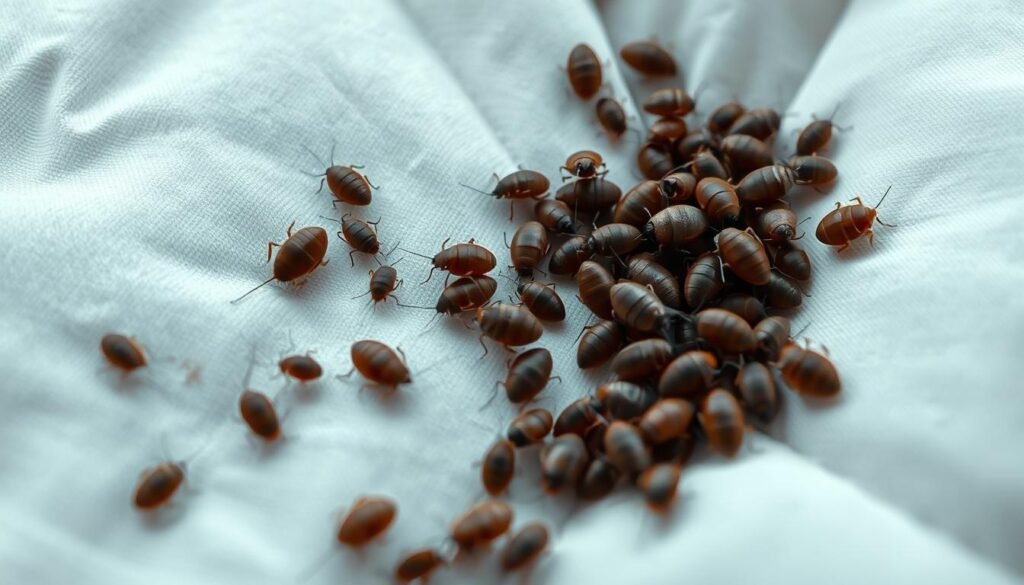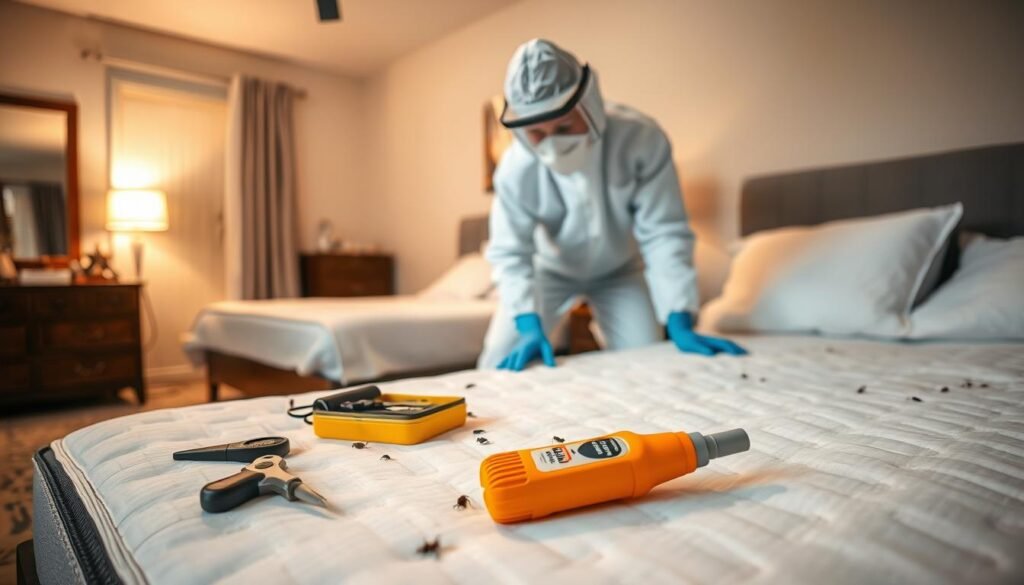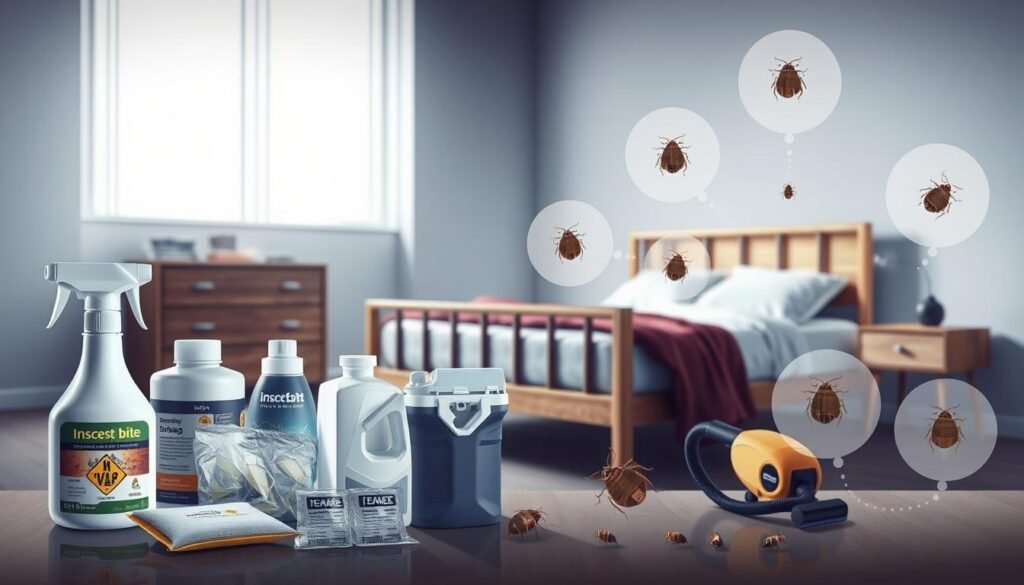One in five Americans has either bitten by bed bugs or knows someone who has. This shows how common these tiny pests have become. Bed bugs are parasites that bite humans and animals for blood, usually while you sleep.
Despite myths, they thrive in both clean and messy spaces. What they need is warmth and hiding spots, not dirt.

These insects hide in beds, furniture, and even clothing, feeding every few days. Bites often show up as red marks on exposed skin like your arms or neck. But reactions vary: some feel nothing, others get itchy bumps or blisters.
Severe allergies are rare, but symptoms might take days to appear.
Bed bugs hitchhike everywhere—from hotels to buses—and can survive months without food. Their spread has risen due to travel and pesticide resistance. This makes infestations a nationwide issue.
Key Takeaways
- 1 in 5 Americans has encountered bed bugs or knows someone who has.
- Bed bugs bite exposed skin like faces and arms, but reactions vary from person to person.
- Bites can take 1–14 days to show up as red marks with darker centers.
- Infestations spread through travel, hiding in luggage, clothes, and furniture.
- Cleaning alone won’t stop bed bugs—they survive in even the cleanest homes.
Understanding Bed Bug Bites and Their Impact
Bed bugs look for humans to feed on their blood. But, their ways and effects can be confusing. Here’s what you need to know about why they target you and how they act.
“Approximately 30 to 60% of people never develop a reaction to a bedbug bite.” – Pest Control Technology
What Makes Bed Bugs Bite Humans
- They are drawn to body heat, carbon dioxide, and chemicals from the skin.
- They mostly bite at night but can also bite during the day.
- They follow warmth and scent trails to find hosts.
The Biology Behind Bed Bug Feeding Habits
Bed bugs inject anesthetic saliva before biting. This makes you unaware of the bite. They feed for 3–10 minutes before leaving. Their survival strategy includes:
| Fact | Feed every 3–7 days |
|---|---|
| Survival | Can live up to a year without a blood meal |
| Size | 1–7mm long, reddish-brown |
Common Misconceptions About Bed Bug Bites
| Myth | Fact |
|---|---|
| Bed bugs spread diseases | No evidence of disease transmission |
| Bites hurt immediately | Saliva numbs the skin |
| Only dirty places get infestations | They thrive in clean and cluttered environments alike |
Reactions to bites vary—some show no marks for days. If you’ve been bitten by bed bugs, knowing these truths helps avoid misdiagnosis and delays in treatment.
How to Identify If You’ve Been Bitten by Bed Bugs
Spotting bed bug bites early can prevent an infestation. Here’s how to tell if you’ve been bitten.
Distinctive Patterns of Bed Bug Bites
Bed bug bites show up as red, swollen welts. They often form clusters or straight lines. Look for:
- Dark red centers surrounded by redness
- Bites on arms, neck, or face (common exposed areas while sleeping)
- Clusters of 3-5 bites in a row (nicknamed “breakfast, lunch, dinner” patterns)
- Delayed reactions—some people don’t see marks for 2-3 days
Differentiating Bed Bug Bites from Other Insect Bites
Bite patterns vary from other pests:
- Bed bugs: Linear clusters on upper body
- Mosquitoes: Single, raised bumps anywhere on skin
- Fleas: Small red dots with a dark center on legs/ankles
- Spiders: Rare, usually two punctures, not clusters
When to Seek Medical Attention for Bites
Visit a doctor if you notice:
- Difficulty breathing or swelling of face/mouth (allergic reaction)
- Pus, warmth, or spreading redness (infection signs)
- Bites lasting longer than 2 weeks without healing
Bed bug bites rarely spread diseases. But scratching can cause infections. If symptoms last, see a healthcare provider right away.
Bitten by Bed Bugs: Symptoms to Watch For
If you’ve been bitten by bed bugs, symptoms can vary a lot. Some people get red, swollen marks right away. Others might not show any signs at all.
Common signs include raised red welts, small clusters of bites, or a line of three to four marks. This pattern is sometimes called the “breakfast, lunch, dinner” pattern. These bites often itch intensely, burn, or blister in severe cases.
- Physical signs: Reddish welts with dark centers, itching, and swelling. Bites may form straight lines on exposed areas like arms or neck.
- Delayed reaction: You might not feel the bite at first. Anesthetic in bed bug saliva delays symptoms for hours or days.
- Secondary effects: Scratching can lead to skin infections, while stress from infestations may cause sleep disruption or anxiety.
Bed bug bites often appear in distinct groupings, making them easier to distinguish from other insect bites.
Severe reactions, like hives or fever, are rare but possible. If bites become infected or cause breathing difficulties, seek medical care. Remember, not everyone reacts visibly—even if you don’t see bites, check bedding for dark fecal spots or shed skins.
Bed bugs don’t spread diseases, but their symptoms can disrupt daily life. If you notice symptoms, act quickly to prevent infestations from spreading.
Immediate Steps to Take After Discovering Bed Bug Bites
If you think you’ve been bitten by bed bugs symptoms, act fast. This is to deal with the bites and any possible infestations. Follow these steps to lessen health risks and stop the problem before it gets worse.
Cleaning and Treating the Affected Area
Calm irritation by:
- Washing bites with soap and water to prevent infection
- Applying a cold compress to reduce swelling
- Using calamine lotion or hydrocortisone cream to soothe itching
Avoid scratching to prevent scarring or secondary infections. Over-the-counter antihistamines like Benadryl can also ease inflammation.

Inspecting Your Home for Bed Bug Signs
Search thoroughly for bed bugs in areas like mattress seams, headboards, and furniture crevices. Look for:
- Small blood stains or dark droppings on sheets
- Translucent egg casings or shed skins
- Live bugs (¼ inch long, reddish-brown)
Use a flashlight and magnifying glass for hard-to-see spots. Over 1 in 5 U.S. households have faced infestations, so vigilance matters.
Documenting the Infestation
Take photos of bites and physical evidence. Keep samples in sealed bags for professionals. Log dates, locations, and symptoms. This documentation helps exterminators target treatment zones effectively.
Bed bug sightings have increased by 500% in the last decade, according to the National Pest Management Association.
Acting fast reduces the chance of bites worsening or infestations spreading. Contact pest control if you find signs of activity.
Effective Treatments for Bed Bug Bite Relief
If you’ve been bitten by bed bugs, relief starts with understanding how to ease symptoms while addressing the infestation’s root cause. Most bites heal within one to two weeks without medical intervention, but these steps can reduce itching and discomfort during recovery.
- Use over-the-counter antihistamines like Benadryl or Zyrtec to calm allergic reactions. Take as directed to reduce redness and swelling.
- Apply hydrocortisone cream directly to affected areas twice daily. This corticosteroid cream numbs skin irritation and stops itching.
- For severe reactions, consult a doctor about prescription-strength antihistamines or oral steroids.
Home remedies also provide quick relief:
- Cool the area with a cloth wrapped ice pack for 10-15 minutes at a time.
- Mix baking soda with water to form a paste, then gently rub on bites for 10 minutes before rinsing.
- Add colloidal oatmeal to lukewarm baths to soothe multiple bites at once.
Avoid scratching to prevent infections. Clean bites daily with soap and water before applying treatments. If redness spreads or pus forms, seek medical care immediately. Pair these steps with thorough home inspections to eliminate the source of the problem.
Eliminating Bed Bugs From Your Home
To get rid of bed bugs, you need to do some work at home and get help from experts. Start by finding where they hide and use methods that kill them. Here’s a step-by-step guide to fight an infestation.

DIY Bed Bug Removal Methods
Start with heat: wash fabrics in hot water and dry at 130°F for 30 minutes. Steam clean mattresses and furniture to reach 130°F. Seal cracks in walls and furniture with caulk. Use mattress encasements to trap bed bugs and starve them over time.
- Freeze items at 0°F for 4+ days to kill bed bugs
- Use diatomaceous earth in cracks to dehydrate the insects
- Vacuum daily and dispose of the bag immediately
When to Call Professional Exterminators
“Professional pest control is often needed to fully eliminate bed bugs,” states the CDC. They use heat treatments (135°F–145°F) or cold treatments with liquid nitrogen. If DIY methods fail, or if bed bugs spread beyond one room, contact a licensed exterminator.
The Cost of Bed Bug Treatments in the U.S.
| Method | Cost Range |
|---|---|
| Heat treatments | $1,200–$3,000 per treatment |
| Chemical treatments | $300–$800 per treatment |
| Multi-visit plans | $2,500–$5,000+ for severe cases |
Prices change based on home size and how bad the infestation is. Heat treatments need more visits but work better.
After treatment, keep an eye on things with bed bug interceptors weekly and watch for droppings. It might take weeks or months to get rid of them, depending on what you choose.
Preventing Future Bed Bug Infestations and Bites
by following these tips every day.
Protect Your Living Space
- Wrap mattresses and box springs in bed bug-proof encasements to trap existing pests and block new infestations.
- Declutter regularly—bed bugs hide in piles of clothing, books, or furniture crevices. Vacuum weekly, focusing on seams, tufts, and edges of mattresses.
- Seal cracks in walls and baseboards to eliminate hiding spots. Use caulk for gaps larger than 1/16 inch.
Stay Vigilant While Traveling
Prevent bringing hitchhikers home with these actions:
- Inspect hotel mattresses for bitten by bed bugs signs: dark specks, eggs, or shed skins near seams.
- Keep luggage on metal racks, not floors. After trips, wash all clothing in hot water or seal them in plastic bags until laundry day.
- Air out suitcases outdoors. Consider portable steamers or heating devices rated for luggage sanitization.
Spot Early Signs Before They Spread
Act quickly if you notice:
- Small red marks on skin that itch but don’t swell immediately
- Rusty-colored stains on sheets (crushed bed bugs)
- A sweet, musty odor in sleeping areas
Monthly checks under baseboards and in electrical outlets can catch clusters before they multiply. Early detection stops exponential growth—females lay up to 250 eggs in a lifetime, doubling populations rapidly.
Conclusion: Taking Control of Your Bed Bug Situation
Dealing with bed bug bites means spotting symptoms early and acting quickly. If you see clusters of itchy welts or red marks, it’s a sign of an infestation. This requires immediate action. Knowing these signs can stop the problem before it gets worse.
Bed bugs love places where people share spaces, like hotels or apartments. They spread fast if not noticed. Early treatment stops severe outbreaks and saves money in the long run.
Professional pest control is usually needed because bed bugs breed fast. Adult females can lay hundreds of eggs in their lifetime. DIY methods often fail because bed bugs hide in small spaces. Experts use heat treatments and specific pesticides for effective removal.
Even clean homes can get infested, so don’t wait to act. Over 90% of pest experts deal with bed bugs every year. This shows how common they are and why you need expert help.
Prevention starts with checking your luggage after traveling and inspecting secondhand furniture. Sealing cracks in walls and using mattress covers blocks their entry. If bites keep happening, see a doctor to prevent infections from scratching.
While bed bugs don’t spread diseases, their impact on sleep and stress is real. By being vigilant, getting professional help, and taking preventive steps, you can take back your space and protect your health.
FAQ
What are bed bugs and where do they come from?
Bed bugs are tiny, blood-sucking insects that feed on humans at night. They are found in homes, hotels, and places with lots of people.
How can I tell if I’ve been bitten by bed bugs?
Look for red, swollen welts on your skin, often in groups or lines. If you’re not sure, ask an expert.
What are the symptoms of being bitten by bed bugs?
Symptoms include itching, red welts, and small blood spots on sheets. Severe reactions might cause blisters or hives. Everyone reacts differently.
How do I treat bed bug bites?
Wash the bite area, use cold compresses, and try over-the-counter treatments. These can help with itching and swelling.
Are bed bugs dangerous? Do they transmit diseases?
Bed bugs are not dangerous and don’t spread diseases. But, their bites can be very uncomfortable and stressful.
What should I do if I suspect a bed bug infestation?
Look for signs like live bugs, shed skins, and fecal spots. Document what you find and get professional help if needed.
How can I prevent bed bug infestations in the future?
Use mattress encasements, reduce clutter, and check secondhand items carefully. Also, be careful when traveling.
When should I consider hiring a professional exterminator?
If DIY doesn’t work, or if the problem is big, it’s time to call the pros. They specialize in getting rid of bed bugs.
